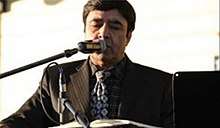Faiz Karizi
| Faiz Karizi فيض كاريزی | |
|---|---|
 | |
| Background information | |
| Birth name | Faiz Karizi (فيض كاريزی) |
| Born |
1953 (age 64–65) |
| Genres |
Folkloric music Classical Music Ghazals |
| Occupation(s) | Singer |
| Years active | 1978–present |
| Labels | Various |
Faiz Karizi (Dari: فيض كاريزی) (born 1953) is a popular Afghanistani singer. He is ranked as the most prolific folkloric singer of Afghanistan and has been referred to as that country’s “King of Folklore Music.” Now based out of Sweden, he often tours Europe, United States and most recently Australia for performances.
Background
Faiz was born in Kar-e-Zamin, a suburb of Kabul. During his high school years he participated in social activities, prompting him to enter the music scene of those gatherings. He was reportedly a very avid learner of music and when he started singing, he was able to make a wide following among his schoolmates during this time. With the encouragement of his peers and also his instructors, he was urged to sing professionally as a folk singer. Thus began a journey of fame for the graduate. He sings in Dari, Hazaragi and sometimes in Pashto.
Fame
Faiz first appeared on Afghanistan’s national television in 1978. He quickly became a renowned singer, his fame paralleling the initial and quick rising popularity of his high school years. During this time he started recording various albums, most of them of his live performances. He became so popular that by the early to mid 80s, he was ranked as the most popular singer in that country. Although most of his songs were folkloric in nature and some renditions of other pop songs, he eclipsed all other singers for public adulation. By late 80s, he became a household name and the first choice wedding singer. During his rise, he regularly performed with Beltoon and Hamidullah Charikari, amongst others.
After a brief period in Peshawar, Pakistan, he emigrated to Europe and now resides permanently in Sweden, continuing his music career in exile, alongside his sons who form part of his backing musical party.
External links
| Wikimedia Commons has media related to Faiz Karizi. |